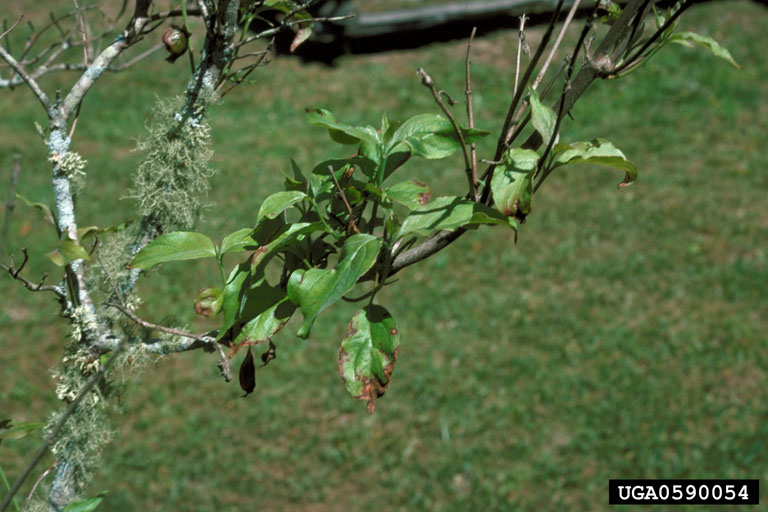
by Daniel J. Leonard | Mar 29, 2017
Everyone, or at least everyone fortunate enough to grow up in the South, has a fond memory tucked away of a sight or smell of a plant that reminds them of the good old days. Maybe it’s the ancient camellia at your grandmother’s house that just feels like home when you see it. Maybe it’s a persimmon tree with fruit weighing on the branches, the smell of baked persimmon bread cooling in the kitchen close behind. For me and countless others, it’s the sight of the iconic native flowering dogwood (Cornus florida) blooming each spring in the understory of Panhandle forests. However, if you’ve been paying attention, the spring dogwood bloom has diminished with each passing year, leaving many folks wondering what happened. As with many things, the answer is multi-faceted and complicated.
First, as homeowners who have grown dogwoods for many years are well aware, dogwoods are notoriously susceptible to harsh site conditions. In the landscape setting, much of the difficulty in growing dogwoods may be attributed to Florida’s frequent extended droughty periods and improperly citing the trees in a full-sun location. dogwoods naturally prefer a cool, moist root zone and protection from the hot afternoon sun; failure to provide such a setting will most likely lead to scorched-appearing foliage, overall poor performance and a short-lived tree.
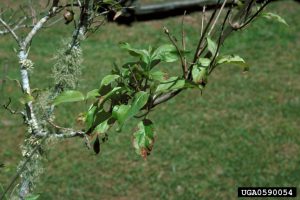
Various Dogwood Leaf Spots
More problematic are the many diseases dogwoods are prone to, including several fungal leaf spots, cankers and mildew diseases, all of which impair their ability to create energy and store the needed nutrients to survive tough periods (frequent droughts). All of these diseases are much more problematic in the unseasonably warm, wet winters and cool, wet springs Floridians have been experiencing with regularity over the last decade. It is good practice to actively clean up any fallen, diseased leaves as well as to prune out any obviously dead or diseased wood to prevent problems from spreading further, but total suppression of these diseases is impractical for most homeowners.
As if all of those problems weren’t enough, the most sobering issue currently facing flowering dogwood is a fungal disease known as dogwood anthracnose (Discula destructiva). D. destructiva has been confirmed responsible for the decline of dogwoods in more upland areas around the foothills of the Appalachians and has been surmised to have moved south into the coastal plain, although its presence in our area has largely been undocumented. As with other pathogens, disease incidence is increased in already stressed trees as well as in mild, wet-weather conditions in the spring and fall. Symptoms of D. destructiva usually begin with purplish spots on the margins of leaves in early summer, with infected leaves hanging onto the tree through winter. The disease then spreads down through the tree and manifests itself as a sort of dieback of twigs and limbs, eventually forming cankers and killing the tree.
As dire as the dogwood situation may seem, there are some potential solutions. First, if you must plant a flowering dogwood, make sure you give it an ideal situation. Irrigate when rainfall is inconsistent, apply a layer of an organic mulch (pinestraw, wood chips, etc.) at a depth of 2”-3”, and plant in a protected, shady situation. If growing a native dogwood might seem too challenging, there is a related species from Asia called kousa dogwood (Cornus kousa) that deserves to be planted more. Kousa dogwood is not a perfect tree but it retains most everything we love about native dogwoods without the disease issues!
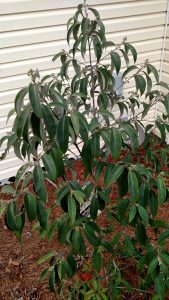
Young ‘Empress of China’ in the author’s lawn.
Kousa’s retain the classic creamy white flowers, attractive berries in fall, and layered branching (called sympodial branching) of our native dogwoods but also bring a few extra attributes to the table. Kousa dogwood grows to a rounded 15’-20 in height and width, is much more tolerant of cultural extremes than flowering dogwood and is resistant to the various diseases that plague native dogwoods. Also, there is a subspecies of kousa dogwood, Cornus kousa var. angustata that is even evergreen in our area, no more barren limbs in the winter! The most popular selection of this subspecies is a beautiful little tree being marketed as ‘Empress of China’ through the southern living plant collection; I am currently trialing this tree in my yard and it has impressed so far.
So to wrap up, if the decline of the dogwoods has you down, there are three things you can do:
- Give your existing dogwoods some TLC, keep them well-watered in droughty periods and mulch to keep the roots cool.
- Cut out any dead or diseased branches in existing dogwoods and rake and dispose of leaves from previous years that are lying around.
- If you want to plant a new dogwood, try a kousa dogwood (Cornus kousa) as this species is a more than adequate replacement for Cornus florida!
As always, consult your local UF/IFAS Extension Office with any questions or concerns you have regarding your landscape and happy gardening!

by Ray Bodrey | Mar 20, 2017

Figure 1: Edible Landscaping.
Credit: Dr. Gail Hansen, Environmental Horticulture-UF/IFAS
Edible landscaping has become a trend for many gardening enthusiasts. A combination of edible plants along with traditional ornamentals can create an artful presentation. There are some challenges when designing such a landscape, but in those challenges opportunities’ may be found. One of the most difficult challenges is making sure your garden or landscape is healthy and vibrant year-round since many edibles are short-lived annuals. These include plants such as eggplant, pepper, lettuce, artichoke and some annual herbs. There is a solution to this concern. First, know your edible plant’s propagation and maturity months. This way you can offset plantings to ensure color in your landscape. Another key measure is to mix some evergreen ornamentals in with short season edibles and long season edibles. Examples of long season edibles include berry shrubs, fruit trees and biennial or perennial herbs.
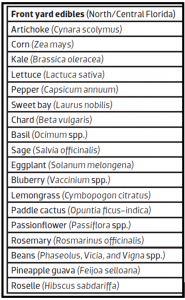
Table 1: North/Central Florida Front Yard Edibles.
Credit: Dr. Gail Hansen, Environmental Horticulture-UF/IFAS.
When designing your edible landscape, think about style and theme to help guide you through the process. A formal design has more straight edges and geometric shapes, whereas the more natural approach has meandering edges and irregular shapes. A color scheme in harmony is very important. Remember, an edible landscape should not just be a production food garden but a visual treat. The goal is not to grow a high yield garden, but only to produce supplemental edibles to make the endeavor worthwhile.
Dr. Gail Hansen, Associate Professor of Environmental Horticulture at the University of Florida, has developed twelve ideas when creating an edible landscape:
- Combine reliable, low-maintenance ornamental with edible plants. Use evergreen ornamentals to maintain enough green structure, so that potential cool season bare spots are not visual.
- Use support structures for an artistic effect and to assist in growth of some plants. Trellises, arbors and even tomato cages are some examples that can be used.
- Use containers in areas to keep the landscape more organized. Planters will also help in maintenance, as plants will be easier to reach and the soil will be easier to manage.
- Create some hard edges in your landscape. Raised beds, garden walls and borders will give defining lines to the landscape and promote a clean appearance.
- A pathway through the landscape will both provide an access to plants and give an inviting appeal. Brick pavers, gravel and mulch are good examples of pathway material.
- Remember color is key. Create a visually pleasing combination of plant color, form, texture and sizes.
- Always start by keeping it simple. So, start small and simple. Then, you can begin filling in the landscape.
- Look for one unique feature to create an added interest to you landscape and provide growth to plants. This could be a shade house for ferns and other hanging baskets or a hay bale, where lettuce, tomatoes or peppers could grow upon.
- Select appealing and easy to grow plants that you want to eat!
- Let plants reach maturity before taking them out of the landscape. For example, rainbow chard will grow larger, if allowed to continue to grow after seed has been produced.
- Use the Florida-Friendly Landscaping principle, “Right Plant, Right Place”, when adding edibles to your landscape. Match the growing needs with the most suitable location.
- Consider your location and layout for irrigation. All plants need some degree of water. An above ground drip irrigation system is usually the most flexible and adjustable irrigation method in regards to overall plant watering needs in a landscape.
Following Dr. Hansen’s ideas will help you create the edible landscape of your dreams. For more information on edible landscaping, please contact your local county extension office for more details.
Supporting information for this article can be found in the UF/IFAS EDIS Publications, “Landscape Design with Edibles” by Dr. Gail Hansen: http://edis.ifas.ufl.edu/pdffiles/EP/EP47500.pdf
UF/IFAS Extension is an Equal Opportunity Institution.
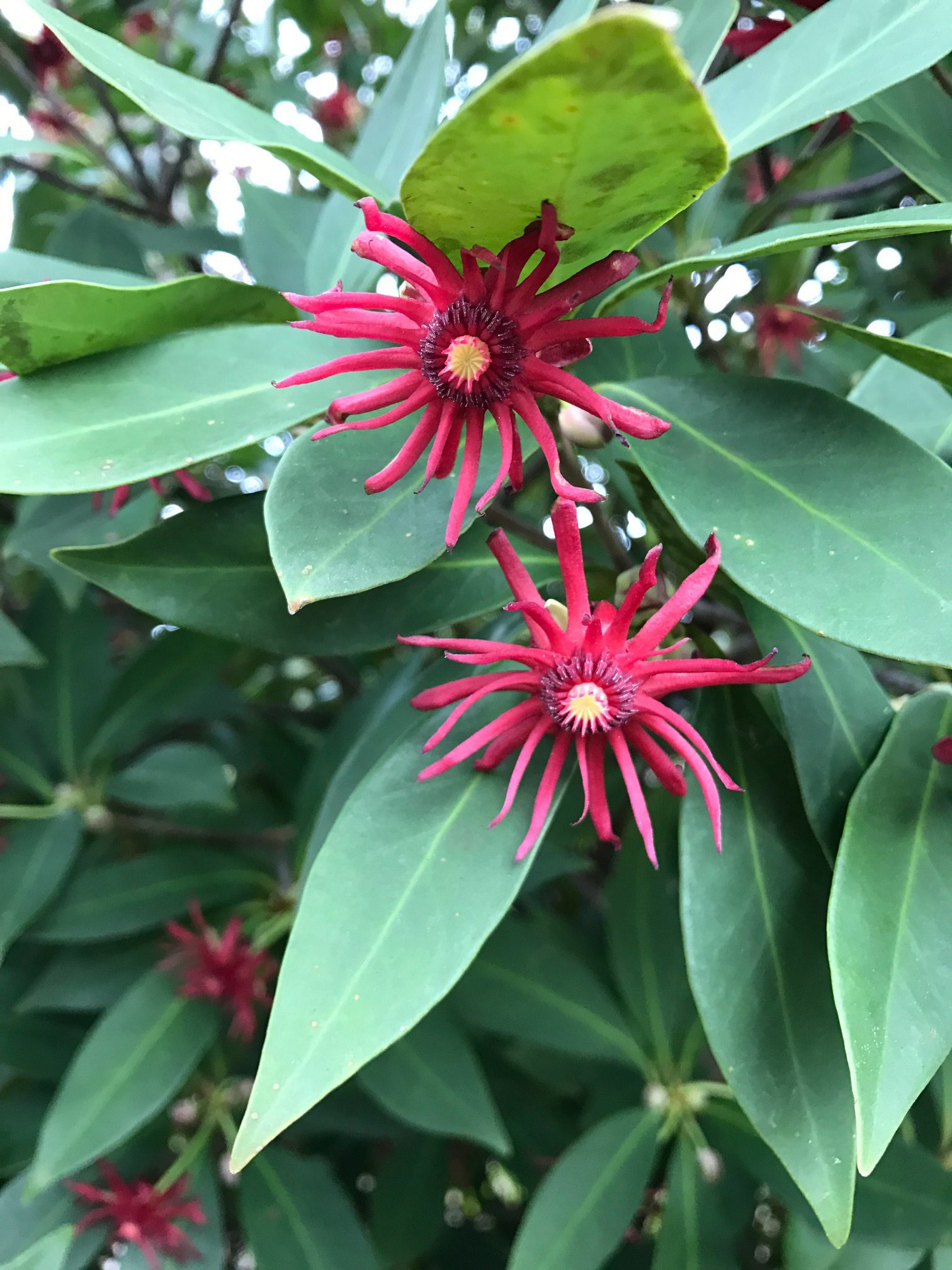
by Mary Salinas | Mar 9, 2017
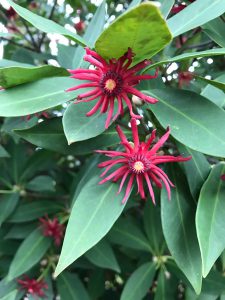
Dark red flowers of Florida red anise arrive in the springtime. Photo credit: Mary Derrick, UF/IFAS Extension.
Springtime brings small but very pretty red blooms on an outstanding native shrub/small tree, Florida red anise (Illicium floridanum). It occurs naturally in the wild in the central and western panhandle of Florida and west along the gulf coast into Louisiana. Its natural environment is in the understory along streams and in rich, wooded areas.
This is a great shrub for a part shade to shady and moist area in your landscape. The dense foliage, dark green leaves and the fact that it is evergreen all year makes it a great choice for an informal hedge. Plan for it to grow to a maximum height of 12 to 15 feet.
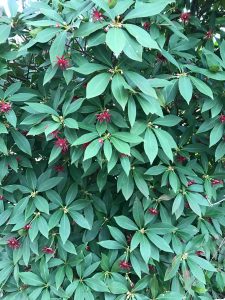
Dense growth habit of Florida red anise. Photo credit: Mary Derrick, UF/IFAS Extension.
The leaves have a licorice-like aroma when crushed but this is NOT the species that gives us the edible culinary anise. Maybe it is that aroma that makes this a relatively pest-free plant!
Yellow anise (Illicium parviflorum) is a very similar native shrub but has small yellow flowers and adapts better to a drier environment. The native range of the yellow anise is north central Florida.
by Matt Lollar | Feb 11, 2017
There are a number of reasons to remove large limbs from mature trees. The three most common reasons are to either remove dead wood, to keep limbs from interfering with one another and rubbing or growing together, or to keep the tree from having narrow crotch angles. (“Narrow crotch angle” is not a very charming phrase, but it simply refers to branches that grow at angles less than 45° relevant to the trunk.)

Photo Credit: Virginia Cooperative Extension.
Removing tree limbs larger than four inches in diameter should be done with care. Three cuts per limb are often needed to avoid tearing the bark down the side of the tree’s trunk.
- Make the first cut on the underside of the branch about 18 inches from the trunk. Undercut one-third to one-half way through the branch.
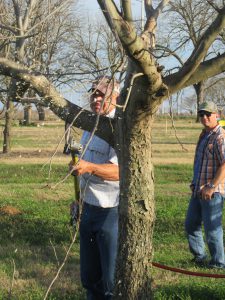
First Cut. Photo Credit: University of Florida/IFAS Extension.
- Make the second cut on the topside of the branch an inch further out on the branch; cut until the branch breaks free.
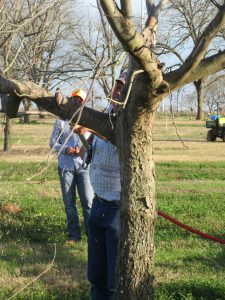
Second Cut. Photo Credit: University of Florida/IFAS Extension.
- Before making the final cut, identify the branch collar. The branch collar grows from the stem tissue around the base of the branch. Make pruning cuts so that only branch tissue (wood on the branch side of the collar) is removed. Be careful to prune just beyond the branch collar, but don’t leave a stub.
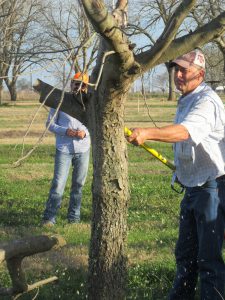
Final Cut. Photo Credit: University of Florida/IFAS Extension.
It is important to take your time whenever working with power equipment and trees in your landscape. You usually only have one chance to get the cut right and you don’t want to injure yourself or ruin your tree.
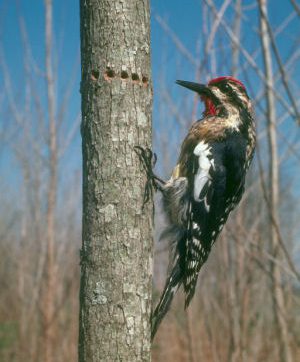
by Daniel J. Leonard | Feb 3, 2017
Have you noticed strange rings of pencil-sized holes on the trunks of certain trees in your landscape recently? If so, take heart that these holes are not emanating from an infestation of destructive insects but rather from a perfectly native, rather attractive migratory woodpecker, the Yellow-Bellied Sapsucker (Syphrapicus varius)!
The Sapsucker is a smallish bird with a chisel-like bill, easily distinguishable by bold black and white face stripes and a conspicuous bright-red crown and throat. If you have any problem identifying it by its features, look to its migration pattern, the Yellow-Bellied Sapsucker overwinters in mild winter areas of the Americas (like Florida’s Panhandle) and causes damage during this period (roughly December through March). If you notice a bird wreaking havoc on your backyard flora this afternoon, it is likely a Yellow-Bellied Sapsucker!
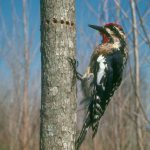
Yellow-bellied sapsucker (male) on pecan
James Solomon, USDA Forest Service, Bugwood.org
Like other members of its family, this woodpecker makes a living by “pecking” holes in trunks of trees and small shrubs about chest-high from the ground and feeds on sap and the occasional insect drawn to the sap. Fortunately, the damage is not usually harmful to the tree except in severe cases where the trunk may be girdled or secondary infection occurs from pests/diseases entering the tree through the holes. Unfortunately for Florida gardeners, this little bird has preferences in which trees it attacks, the majority of which are favorite landscape plants. For example, heavy feeding has been observed, both anecdotally by the author and more scientifically by researchers and birding enthusiasts, on Red Maple, Pecan, Chinese Elm, American Holly, Pine and Live Oak. They also really seem to enjoy any soft-wooded shrub limbed-up in a treelike form like Waxmyrtle, Viburnum and Dahoon Holly. Talk about frustrating!
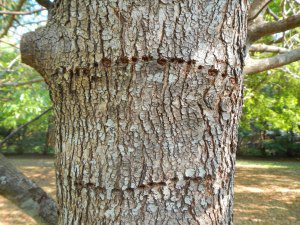
Sapsucker damage in a tree trunk.
Photo courtesy of Mississippi State Extension.
After learning that Sapsucker damage is not usually harmful, most homeowners opt to not control the birds’ feeding. However, if the aesthetic damage is not acceptable in your landscape, there are a few semi-effective control options and a host of other, less-effective home remedies. Wrapping the trunks of favored species with a loose, thick material such as burlap or felt is the preferred method of many ornamental nurseries and tree farms due to the material’s reusability and ease of removal after the migration has passed. Other commercial enterprises have had mixed success with hanging visually frightening CDs, pie plates and the like from low branches. Even less success has been seen with other homemade “cures” ranging from rubbing trunks of favored trees with Ivory soap to the use of sticky materials to deter perching. Shooting or trapping Yellow-Bellied Sapsuckers is not permitted as the birds are protected by state and federal wildlife law. As always, please contact your local UF / IFAS Extension office for advice and recommendations for other methods of discouraging unwanted bird visits!
Happy New Year and good gardening!
by Larry Williams | Jan 26, 2017
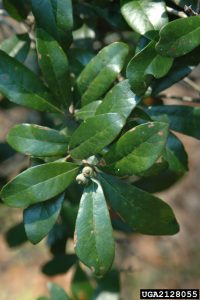
Live oak with immature acorns. Photo credit: Wendy VanDyke Evans, Bugwood.org.
Do you have more acorns than you know what to do with? When oaks produce loads of acorns, it sometimes is called a “mast” year. Do you remember the oak tree pollen and all those catkins that fell from oaks earlier in spring?
Catkins are the male flowers in oaks. Some people refer to them as tassels or worms. The airborne pollen from these catkins were part of the reproductive process in fertilizing the female oak flowers that ultimately resulted in all of these acorns. Oaks produce separate male and female flowers on the same tree. Female flowers in oaks are very small. You’d have to look very close to see them. Many oaks did well in their reproductive efforts this spring. Acorns are oak seeds. This entire process is part of the cycle of life.
There are theories about mast years, wildlife’s use of these acorns and what gardeners can expect next year as a result of this year’s abundant acorn crop. Timing of mast years is still a mystery. Numerous theories exist ranging from weather to geography to the life cycles of predators.
The most likely reason for high production seems to be weather-related. When oak trees have favorable weather at the time of oak flowering and good growing conditions, the mast seems to be increased.
But mast years happen irregularly, making it difficult to understand what causes a mast year. Heavy acorn production can occur twice in a row or it might be separated by several years or more. There’s no good way to predict it.
Mast years are important to wildlife, as acorns are an important food for many animal species. In low crop years, birthrate for some wildlife species, such as squirrels, will decline the following year. This also may involve increased competition for food and survival rates. The recent crop means that more young are likely to be produced by animals that forage for acorns.
Wildlife play a big role in forest regeneration. When acorns drop out of oaks, many animals help distribute these seeds. Squirrels can bury hundreds of acorns. Some of these acorns germinate and grow to become the next generation of oak trees. Some will be eaten by birds, bears, deer, rodents, including squirrels, and other wildlife. Rodents are in turn eaten by carnivores and deer browsing shapes which kinds of plants become established and survive. All those acorns have far-reaching impact on wildlife and our forests.
So, try to keep this in mind as you are fussing with all those acorns in your lawn and landscape this season.

















